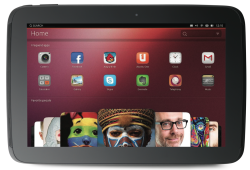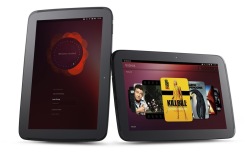Canonical shows Ubuntu Tablet experience

![]() Home on the Ubuntu Tablet.
Home on the Ubuntu Tablet.
Source: Canonical
In the run up to Mobile World Congress next week, Canonical has presented what it plans to offer with its tablet experience. The company's aim is to have a range of convergent devices, with phones, tablets, desktops and TVs all running the same code base and offering optimised Unity-based user interfaces. Ubuntu for TV was unveiled at CES in January 2012. Next, it launched Ubuntu for Phones at the start of January 2013. But the third of the range of Ubuntu devices, tablets, had yet to be shown – now, Canonical's Mark Shuttleworth has presented the company's concept for tablets in a video:
Mark Shuttleworth introduces the Ubuntu Tablet experience.
The user interface shown appears to be mostly an expanded and enhanced variant of the Ubuntu for Phone interface: HTML5 web apps and Ubuntu's own API using web apps, sitting alongside native C/C++ applications using Qt or OpenGL, with rounded button icons and a edge-swipe-driven user interface.
Over and above the phone experience, Canonical highlights features such as support for "real multitasking", where a phone app and tablet app can share the same screen, and "secure multiuser" support with full disk encryption and support for multiple accounts on one device. These features are not unique: Samsung has support on many of its phones and tablets for running two Android apps in split screens and Android 4.2 introduced support for multiple user accounts, building on Android 3's encryption.
A voice controlled HUD, shown but not demonstrated at the Ubuntu for Phones launch, will also feature on the Ubuntu Tablet. The Canonical designers say the interface supports screen sizes from 6 to 20 inches and 100 to 450 PPI density.

![]() From lock screen to content launcher.
From lock screen to content launcher.
Source: Canonical
The Ubuntu Tablet will also offer the ability to be docked with keyboard, mouse and monitor and run a full Ubuntu Unity desktop, providing the device is powerful enough. Canonical is somewhat contradictory about minimum hardware specifications needed to run the tablet operating system. A Media FAQ says that a dual core Cortex A9 processor or similar with 1GB RAM and 8GB of storage is sufficient, but Canonical's brochure![]() bumps that requirement up to a dual core Cortex A15 processor with 2GB of RAM for an entry level device with no "desktop convergence". For desktop convergence, the specification rises to a quad core Cortex A15 and 4GB of RAM. Canonical is using the same technique as it does on Ubuntu for Phones to ease compatibility by ensuring that the Linux kernel it ships is compatible with Android-oriented Board Support Packages.
bumps that requirement up to a dual core Cortex A15 processor with 2GB of RAM for an entry level device with no "desktop convergence". For desktop convergence, the specification rises to a quad core Cortex A15 and 4GB of RAM. Canonical is using the same technique as it does on Ubuntu for Phones to ease compatibility by ensuring that the Linux kernel it ships is compatible with Android-oriented Board Support Packages.
Tomorrow, 21 February, Canonical will be releasing the "Touch Developer Preview" of Ubuntu for Phones. That preview and source code, available from developer.ubuntu.com, will also be available for the Nexus 7 and Nexus 10. Canonical says it will be updating the Preview SDK to also support tablet apps. The developer preview is, though, "a developer build and not a consumer-ready release", but should provide a guide to how much work Canonical has to do over the next year.
Some of the literature from Canonical says that "Ubuntu is available now to partners launching tablets in Q4 2013", with the expectation that devices would arrive around the same time as smartphones running Ubuntu for Phones, early 2014. Phone support in Ubuntu is expected to arrive in October 2013, with Ubuntu 13.10, but the company says a converged Ubuntu with support for all four form factors would only arrive in April 2014, with Ubuntu 14.04. The company sees itself working with carriers and hardware manufacturers, but has yet to name any partners who are planning to deliver Ubuntu on phone, tablet or TV.
(djwm)
![Kernel Log: Coming in 3.10 (Part 3) [--] Infrastructure](/imgs/43/1/0/4/2/6/7/2/comingin310_4_kicker-4977194bfb0de0d7.png)

![Kernel Log: Coming in 3.10 (Part 3) [--] Infrastructure](/imgs/43/1/0/4/2/3/2/3/comingin310_3_kicker-151cd7b9e9660f05.png)
















